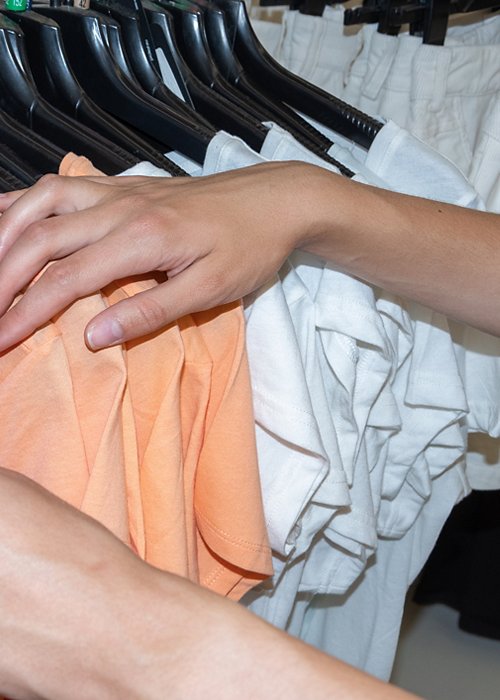Between influencers offering us the latest fashions and the blossoming of large chain shops selling cheap clothes, a new business model based on the compulsive buying of clothes has emerged which has revolutionised the way we dress in recent decades, but has generated serious environmental and social problems. The phrase used to describe this phenomenon is ‘fast fashion’, which indicates the speed with which collections are renewed throughout the year in a cycle of production and consumption that, on the one hand, pushes fashion houses to produce at an increasingly frantic pace, and, on the other, pushes consumers to buy to keep up with trends. Additionally, to encourage the purchase of more clothes, these products are often priced very low. This practice carries a high social cost, which is disproportionately borne by workers, especially women, throughout the supply chain. The fast fashion phenomenon has turned clothes into disposable items, generating a serious problem in the immoderate use of raw materials and the generation of waste. Let's try to find out how and where these clothes are produced and where they end up when we no longer use them.
Fast production
One of the first steps to understand this phenomenon is to look at the label on your clothes. To produce large quantities of clothes, producers go to countries where raw materials and labour are cheap, so on the labels we will very often read that our clothes come from Bangladesh, Cambodia, China, Pakistan, India, Vietnam, Tunisia, Morocco. These are just a few examples. In some of these countries, laws and controls to protect workers and the environment are often insufficient or lacking. The remoteness between the country of production and the country where the product is sold makes it more difficult to control the supply chains, and so from the cultivation or processing of the raw material there can be dozens of steps, which are difficult to trace.
If we read the label, we see that the materials making up the fibres of the clothes are often blended: polyester or nylon, all derived from petroleum, are often added to cotton or wool. Synthetic garments also release millions of particles of plastic microfibres during washing, which end up in the sea. These tiny fibres are ingested by fish and other marine organisms, entering the food chain and eventually ending up on our plates. The long-term consequences of this contamination are yet to be assessed, but they are of great concern.
Consequences at the social level
As mentioned at the beginning, producing and selling low-priced clothes has a very high social cost that is paid by the workers and especially the female workers along the supply chain. For example, in cotton-growing countries like India, keeping prices so low puts farmers at risk of extreme poverty. It is estimated that around 75 million people are involved in the textile supply chain: these people who transform fibre into thread and then into fabric and clothes receive very low wages and have few rights in the workplace.
The story of Rana Plaza, a factory in Bangladesh that collapsed in 2013, resulting in 1,138 deaths and 2,600 injuries, starkly illustrates the grim reality behind the fashion industry: workers were trapped in a dilapidated building that gave way under the weight of the machinery. Since then, many steps have been taken, but not enough to guarantee safe working conditions and decent wages for workers. Even today, the fast fashion supply chain conceals severe violations of basic human rights: enslavement, child labour, exploitation.
Environmental consequences
Textile production is one of the industries with the largest water consumption on the planet. It can take up to 7,500 litres of water to make one pair of jeans, enough for one person's daily needs for two and a half years. The cultivation of cotton, a widely used raw material, requires massive use of fertilisers and pesticides, intensive irrigation that depletes aquifers and diverts water from other essential uses. The dyeing and finishing of textiles also uses a myriad of harmful chemicals, which often end up in waterways through industrial discharges. These toxic substances contaminate water, harm aquatic flora and fauna and can enter the food chain with very serious consequences for human health.
Finally, it must be added that the planned obsolescence of clothing and the disposable attitude typical of fast fashion generate immense quantities of textile waste every year. An estimated 85% of textiles produced end up in landfill, where they accumulate in heaps that decompose with great difficulty or continue to release microplastics and harmful substances into the soil and groundwater for decades.
A radical change
The Slow Fashion movement was born a few years ago to counteract fast fashion and raise awareness of what is really going on in the fashion world. It promotes non-compulsive fashion and encourages people to think before buying an item of clothing, for example by asking themselves whether they really need what they are buying and by checking the quality and the materials the product is made of.
You can also check that the garment bears the Fairtrade Cotton label. This label indicates that the cotton used comes from Fairtrade farmers' organisations that are committed to strict social and environmental standards: use of rainwater for irrigation, minimal use of chemicals or organic farming. Then there is the Fairtrade Textile Standard label, which is applied to textiles and protects the entire production chain. It means that companies are monitored with regard to the respect of workers' rights, working conditions, regular contracts, wages in line with national contracts so that the whole supply chain is traced and controlled. Unfortunately, it is a demanding Standard that companies have not yet chosen to adopt because it implies careful control of all steps in the supply chain by Fairtrade, a third party.
The environmental impact of fast fashion is unsustainable and requires a radical change in the production and consumption model. It is necessary to adopt more sustainable practices, such as using environmentally friendly materials, optimising production processes and reducing waste. Consumers, for their part, can make a difference by choosing durable quality garments, buying from sustainable brands and adopting a more conscious and responsible approach to purchasing. There are countless examples showing that it is possible to create quality products while respecting the environment and people. By choosing carefully what to buy and supporting companies that follow good practices, we can help build a greener future for the planet and for ourselves.
For more details:




